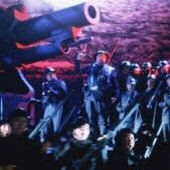Dear Visitors - Welcome to Meeting in Music !
All music lovers are cordially invited to participate at our Meeting in Music collective, a central gathering point for bloggers dedicated to sharing music and enhancing the enjoyment of same. MIMIC features pertinent articles, links to the best classical blogs on the web, and occasional links to sample some of the great music discussed amongst MIMIC members.
Please join us to contribute, partake of what is offered and to chat with fellow music-lovers from around the world. Those enrolling as FOLLOWERS of this blog are encouraged to request posting rights to become contributors.
Are you looking for a specific recording that you just can't seem to find anywhere? Maybe one of your fellow members of the this community can help you. Place your request in the chat box but please keep it on a modest and reasonable level and remember that the more you help others, the more they will try to help you.
On behalf of the MIMIC team
Scoredaddy
Following the guide below you will be able to create the ultimate HQ rip and upload for sharing here at the Meeting in Music Internet Community or on your own blog if you have one.
RIPPING A CD USING EXACT AUDIO COPY (EAC)
1. Start Exact Audio Copy and load the clean and scratchless CD into you drive.
2. Pressing ALT+G will pull track and album info from the FreeDB database if this feature is set up properly.
3. If no info is found the CD is not registered in the database and you will have to type in the info manually.
4. Adjust the Drive Settings according to the model of your drive and enable the ”Create Log-file” option.
5. Adjust the Compression Settings to rip in Flac format at 768 kBit/s. Alternatively rip in the Ape fomat.
6. Rip the CD by pressing Action -> Test & Copy Image & Create CUE Sheet -> Compressed...
7. Check the log-file to see if any ripping errors or AccurateRip inaccuracies were registered.
SCANNING THE COVERS OF THE ALBUM
1. Scans of the front and back covers should be included if available as should the booklet. 300dpi is standard.
COMPRESSING THE FOLDER USING WINRAR
1. Wrap the audio files and images in a folder marked the composer and album name etc.
2. Set Compression method to ”Store” and the volume size to 200000000. Add a 3% recovery record.
3. Compress the folder using a not-too-obvious filename.
UPLOADING TO A FILEHOST AND SHARING WITH THE WORLD
Now all you need to do is to upload the rar-files to a filehost of your choice. Mega.nz is the standard and most stable option but there are many others and some services even feature upload to multiple filehosts. Finally the download links are ready to be presented on your blog.







